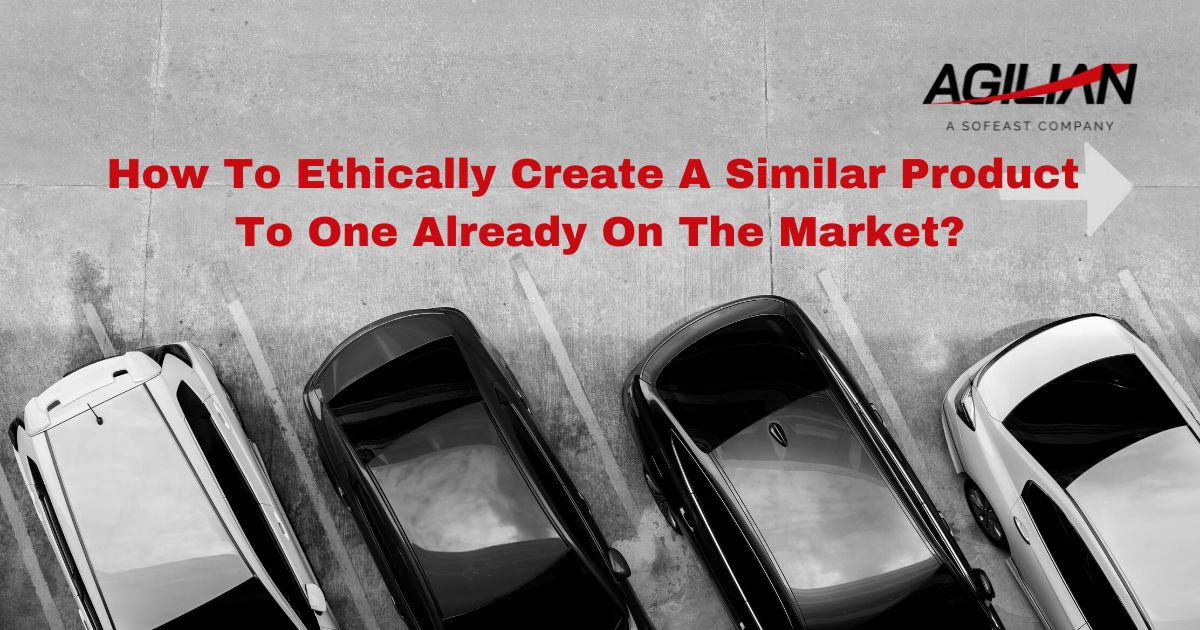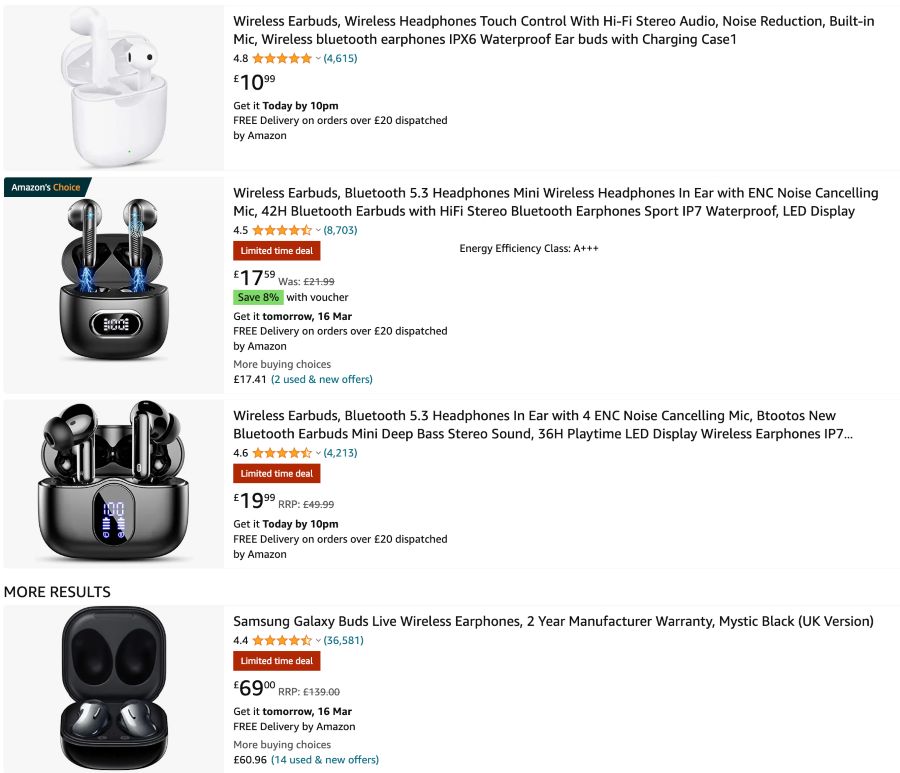
Almost every product niche has a variety of different brands’ products to choose from which are fairly similar. OK, there have been a few particularly innovative products that stand out from their peers launched over the years: Apple’s iPhone and iPod, the Dyson bagless vacuum cleaner, and Tesla automobiles are a few examples. But in general, each product niche is made up of numerous similar products which still sell in good numbers.
So, even if you’re not intending to reinvent the wheel your business can still launch a product that sells well. But the question is, how can you ethically create a product that is similar to one that already exists?
R&D does NOT stand for ‘Rip off and duplicate’
Just because Apple, say, launched their AirPods, doesn’t mean that you can’t also create a new pair of earbuds to sell in the same market.
Let’s just look at a quick Amazon search for earbuds:

As you can see, the marketplace is filled with similar alternatives, some of whom even take some design cues from Apple’s famous AirPods. So, who’s to say that you can’t also make and sell earbuds?
However, we are not talking about making counterfeit copycat products here, or even copying someone’s IP or using their patented designs or functions.
The goal here is to be designing and developing your own new product, even if it looks similar to those that have come before, and then launch it onto the market. Going through a thorough new product development process, including product R&D, takes some time to launch a similar product, but it is the most ethical.
Can you take inspiration from existing products?
Yes, and this is a common approach for companies during their new product design and development process. It’s standard practice to take competitors’ products and to perform a product teardown on them to understand which components are used, the product’s functions, why and how it works the way it does, its design, and more.
Going back to our example of earbuds. Most everyone knows that Apple AirPods come in that stylish white color that is so eye-catching, but you can also legitimately create white earbuds. What would not be ethical would be to create earbuds with exactly the same shape and design. This would infringe on Apple’s design IP.
The same with the components used. If you’re able to understand which components a competitor has chosen it may influence those you use in your products. If the components are custom-made and proprietary IP you can’t use or copy those, but in many cases, they’re obtained ‘off-the-shelf.’ Note that some companies take steps to obscure or hide their components’ origins these days, which is a potential roadblock during teardowns.
So, rather than making a product that’s almost identical, you would benefit from following the approach of altering the color, adding one or more different features, placing switches in a different location to suit your design and purposes, and/or implementing your own, different, control during the development of your new alternative product.
What if an ODM or OEM manufacturer offers me a product to white-label?
When working with an OEM or ODM they may already have their own products that they developed which you can add your logo to, along with perhaps some small cosmetic and functional changes. If you can be sure that the products are their own IP, then it’s safe enough to go ahead in this way (there are plenty of drawbacks to working this way in comparison to working with a contract manufacturer, but that’s a story for a different blog post).
However, some manufacturers in China will work with other businesses like yours, helping develop and mass produce their product and, unfortunately, sometimes offer to produce it for you with some adjustments. This means that you might unwittingly be selling someone else’s IP and be in breach of patents, IP rights, etc. The owner of the product IP will not be very understanding of your situation, even if the manufacturer led you to believe that all was well, and may hold you equally liable for not checking who truly owned the IP. Beware, too, that if the business that owns the IP decides to go to court for legal retribution, it may well be far easier for them to sue you, for example, than to attempt to pursue the Chinese manufacturer.
This is why developing your similar product from scratch is a far safer option when it comes to not falling foul of infringing someone else’s IP.
What do you need to develop your own new ‘alternative’ product?
Your new product development project will go a lot smoother if you already have:
- A clear product brief including how it’s used, where, by whom, materials and components to be used (especially those that have a specific requirement, such as needing to be non-toxic), logo design, etc.
- A budget for the development and marketing
- Consumer research and projected sales volumes
- A quality standard
- A list of certifications and standards that the product needs to comply with to be sold in your target country/ies
- Your research done when considering the competing product example you’re using for inspiration (and maybe tearing down, etc) in order to confirm that it doesn’t have a design patent on it that you might infringe upon.
- 3D CAD drawings and 2D drawings with color, material, finish, and tolerances (these may be based on the example product, but will be differentiated to such an extent that you are not copying it). When doing the industrial design for your product bear in mind that you will also have to invest in tooling for components like the plastic enclosure (assuming your product needs one), so getting one designed that is a unique shape would be a good way to differentiate your brand and product from others on the market.
Once you have drawings in hand, it’s then possible to estimate your tooling costs and, finally, your production unit cost per piece. Following that, it’s all systems go!
Conclusion: Are ‘similar products’ ethical?
Yes, it’s ethical to get inspired by a product that’s currently being sold and to create a competing product that is similar but not the same. What you shouldn’t do is copy the product and/or its design, but on the other hand, you shouldn’t fear making something similar either. Creating innovative products with no equal is the ‘holy grail’ for many inventors, but there have been many businesses that have existed quite happily for years by filling the marketplace with alternative options for consumers to choose from.
Consider automobiles. As soon as one comes out, the competing automakers purchase one, tear it down, and try to understand its manufacturing process and how its features work. Sooner or later, their new models will probably include something fairly similar. With the exception of Tesla, how many new autos have honestly been that different from competing models of other marques (and even that gap is narrowing now that most are launching futuristic new EVs)?
For consumers, variety is the spice of life, and they will generally welcome a greater choice, especially if you’re able to offer an alternative product to ‘big-name brands’ at a lower price point.
Disclaimer…
We are not lawyers. What we wrote above is based only on our understanding of the regulatory requirements, IP rights, and patents for new products. Agilian Technology does not present this information as a basis for you to make decisions, and we do not accept any liability if you do so. Please consult a lawyer before taking action.



